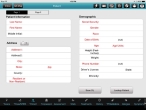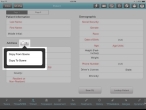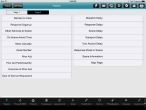Add location and incident data
-
(If you have not done so already) Add a new incident, or open an existing incident, as described Add or edit an incident.
By default, the Scene screen appears. Fields with red text indicate required information.
-
Under Incident, enter data as described in Understand the interface and data entry in it.
Field Information needed Incident Number
A unique incident number assigned by the fire department or dispatch center for every incident to which the department is called.
Note:
- You may need to obtain this number from an alarm or dispatch center.
- If you plan to link this incident to an existing incident in FIREHOUSE Software, the incident numbers must match in both systems.
Date of Service
The date the dispatcher was notified about the incident.
Outcome
How the incident ended, with respect to the patient (the patient was transported, transferred, refused treatment, and so forth).
Transport Type
The type of transportation used to take a patient to a facility for treatment. This is typically an Advanced Life Support (ALS) or Basic Life Support (BLS) apparatus.
Run Type
An indication of what type of run the EMS team is dispatched on.
Example: City, county, and so forth.
-
Under Address, do one of the following.
 Use the iPad's location service to determine the address of your current location
Use the iPad's location service to determine the address of your current location
-
Touch Current Location On.
The button is renamed Current Location Off, your current location is determine by the iPad's location service, and the address for that location appears in the appropriate fields under Address.
Note: If you touch Current Location Off, the button is renamed Current Location On, and the fields under Address are cleared of information.
 Manually type the full street address
Manually type the full street address
-
Touch Address and Address2, and then use the iPad keyboard that appears to type the building number, street direction, and name of the street where the incident occurred.
Note: If the incident occurred in an unincorporated area, use the mailing address for the incident location.
 Type the building number and street direction, and select the street name
Type the building number and street direction, and select the street name
-
For the following fields, enter data as described in Understand the interface and data entry in it.
Field Information needed Street Number
The building or house number in or near where the incident occurred.
Example: In the address 2244 SE Oriole St.,
2244is the number of the building or house in or near where the incident occurred.Street Direction
The directional descriptor appearing before or after the name of a street or highway where the incident occurred.
Example: In the street name SE Oriole St.,
SEis the directional descriptor of the street name.Street Name
The name of the street or highway where the incident occurred.
 Copy the patient's home address as the incident address
Copy the patient's home address as the incident address
Note: You must have already specified a home address for the patient to have address information to copy.
Information on specifying the home address is available in Record the patient's personal information.
-
At the bottom of the screen, touch Patient.
Fields for specifying the patient's name, address, and demographic information appear.
-
To the right of Address, touch the menu with the gear icon, and then choose Copy To Scene from menu that appears.
The address information that was entered on the Patient tab for the incident appears on the Scene tab, under Address.
-
-
Under Address, continue entering data as described in Understand the interface and data entry in it.
Field Information needed City
The name of the city where the incident occurred.
Note: If the incident occurred in an unincorporated area, use the city found in the mailing address for the incident location.
State
The name of the state where the incident occurred.
Zip
The name of the state where the incident occurred, and the numerical code assigned by the U.S. Postal Service to all U.S. jurisdictions.
County
The name of the county where the incident occurred.
Location Type
A description of the location where the incident occurred.
EMD Performed
An indication of whether or not emergency medical dispatching (EMD) instructions were provided by the dispatcher to the caller, so they could immediately help the victim.
EMD Card Number
The number of the card in the emergency medical dispatching (EMD) card set the dispatcher referred to when providing pre-arrival instructions to the caller, so they can immediately help the victim.
Dispatch Complaint
The reason emergency personnel were initially dispatched to the scene.
Number of Patients
An indication of how many victims (patients) require medical assistance at the incident.
-
In the upper left corner of the screen, touch Page 2.
Additional fields related to the scene appear.
-
On Page 2, enter data as described in Understand the interface and data entry in it.
Field Information needed Barriers to Care
An indication of other conditions that patient may have that would impede the delivery of medical assistance.
Example: Hearing or speech impairment, being unconscious, or unable to speak the same language as the emergency medical services (EMS) team.
Response Urgency
An indication of the level of urgency required for treating the patient.
Other Services at Scene
A list of any other emergency services dispatched to the incident.
Example: Fire, hazardous materials, law enforcement, and so forth.
On Scene Arrival Time
A general indication of how long it took for the EMS team to reach the incident scene.
Mass Casualty
An indication of whether or not the incident overwhelms the personnel and/or equipment of the EMS responders by the number and severity of casualties.
Zone Number
The identifying number or name assigned to the area the incident occurred in.
Prior Aid
A list of what aid was given to the patient before the medics arrived.
Prior Aid Performed By
A description of the person who performed the prior aid on the patient.
Outcome of Prior Aid
An indication of whether the prior aid improved or worsened the patient's condition.
Type of Service Requested
The type of EMS service requested for the scene.
Dispatch Delay
A reason there was a delay in the dispatcher placing an incident call to the EMS team.
Example: Uncooperative caller, language barrier, high call volume, and so forth.
Response Delay
A reason there was a delay in the EMS team responding to the incident.
Example: Staff delay, weather, vehicle failure, hazardous materials at the scene, and so forth.
Scene Delay
A reason there was a delay the EMS team reaching the patient at the scene.
Example: Crowd, directions, safety, weather, language barrier, and so forth.
Transport Delay
A reason there was a delay in transporting the patient to a medical center.
Example: Crowd, distance, weather, vehicle failure, vehicle crash, and so forth.
Turn Around Delay
A reason there was a delay in returning the EMS team to duty after the incident.
Example: Clean-up, decontamination, equipment replenishment, incident documentation, and so forth.
Response Mode to Scene
An indication of whether lights and sirens were used while traveling to the scene.
Scene Information
A list of other units and crew members at the incident scene.
Map Page
The page number the location can be found on in the fire department's map book.




